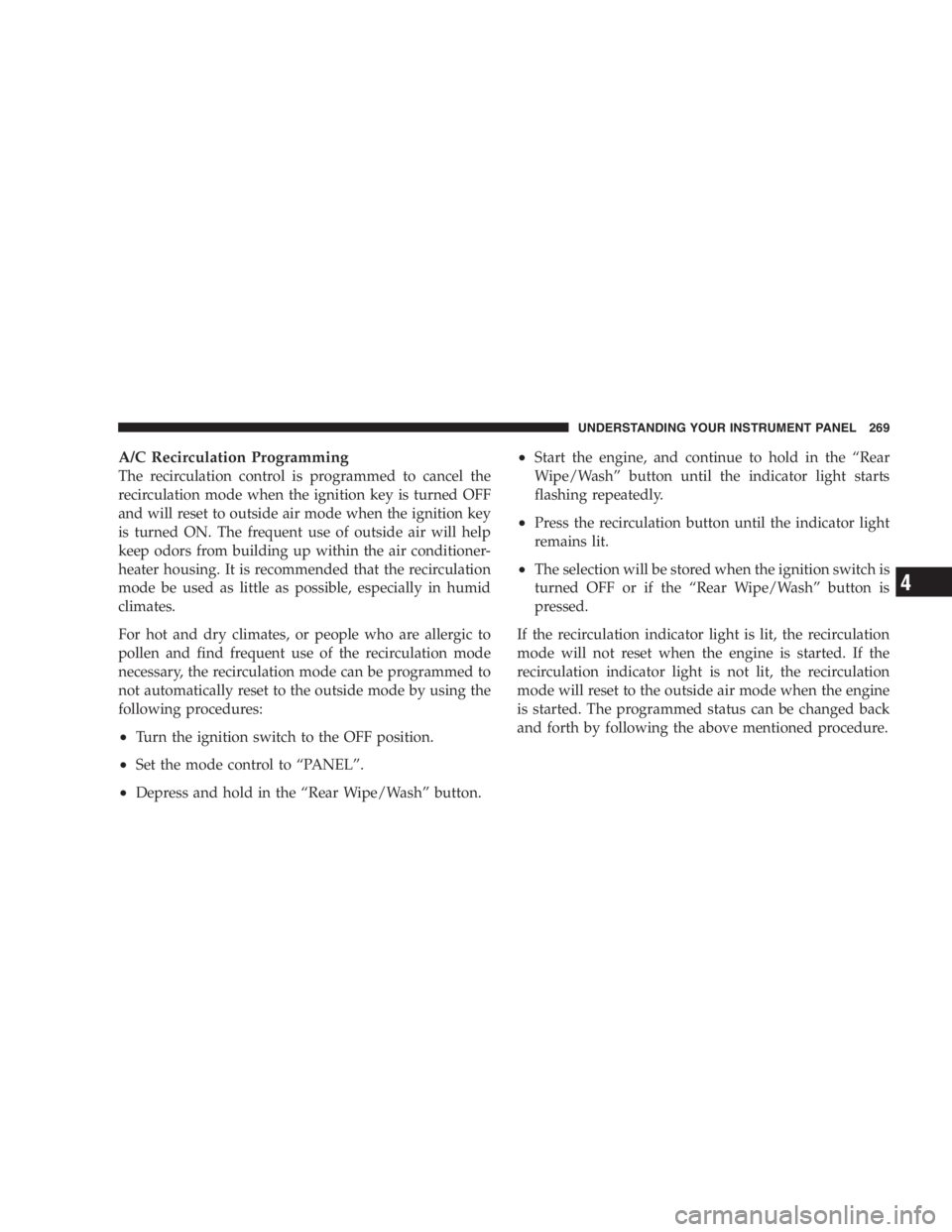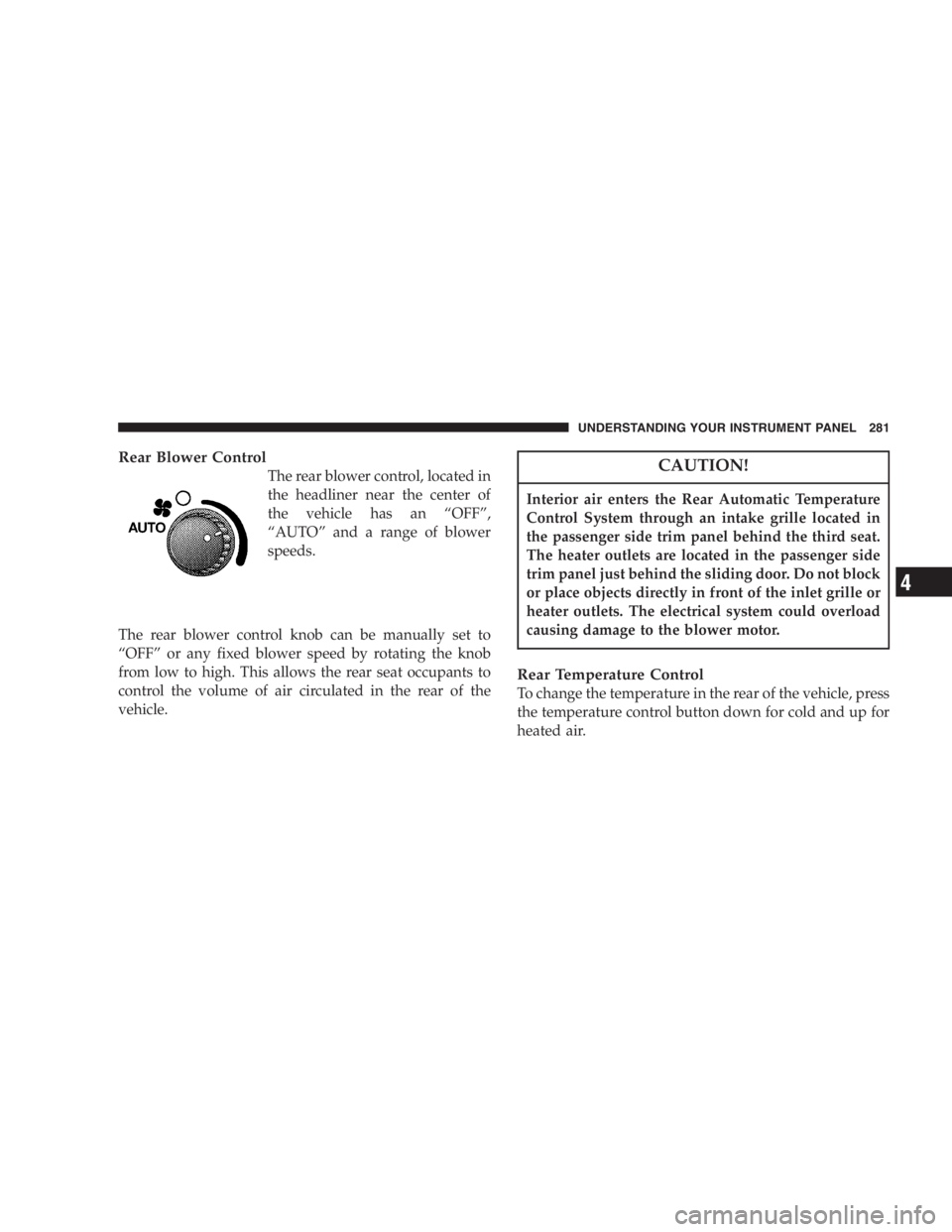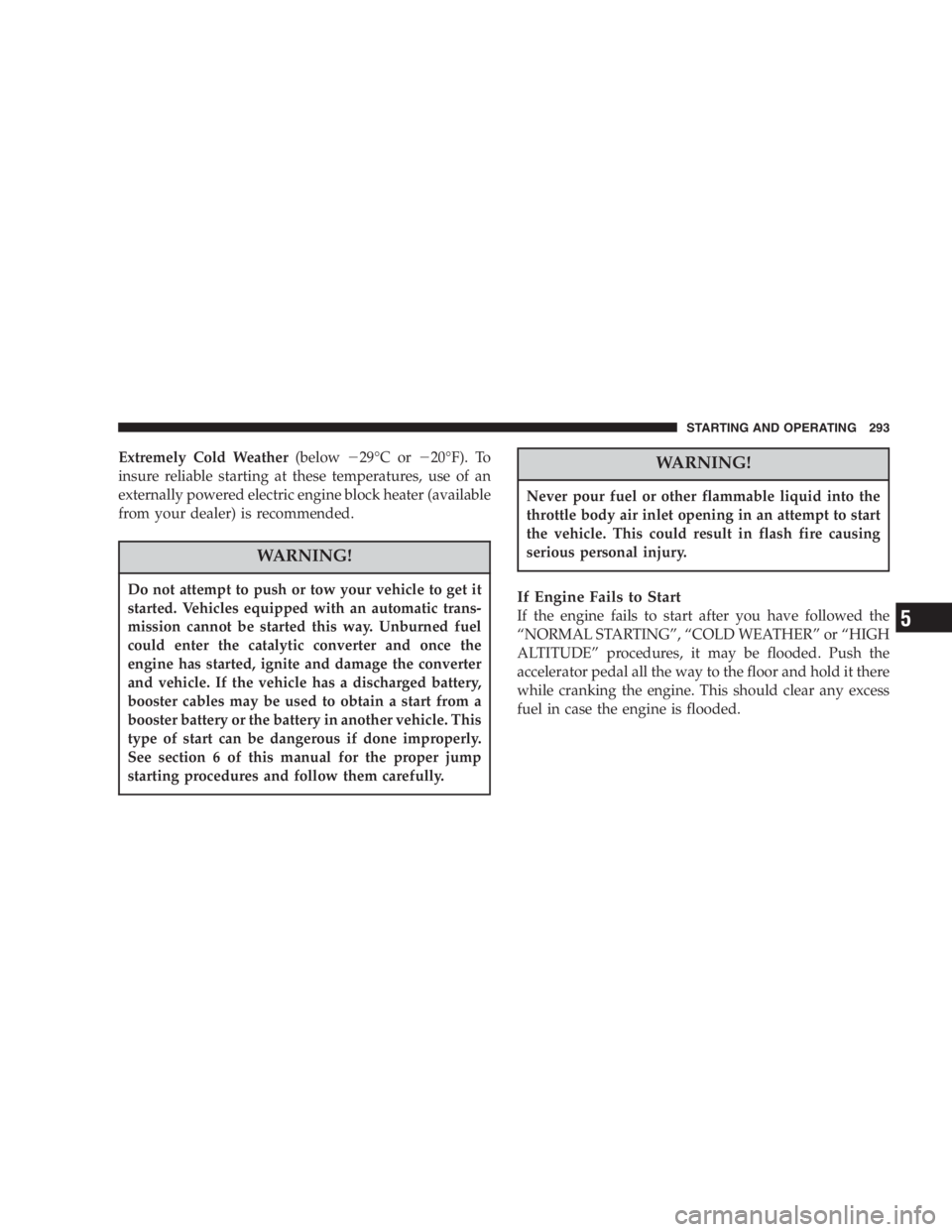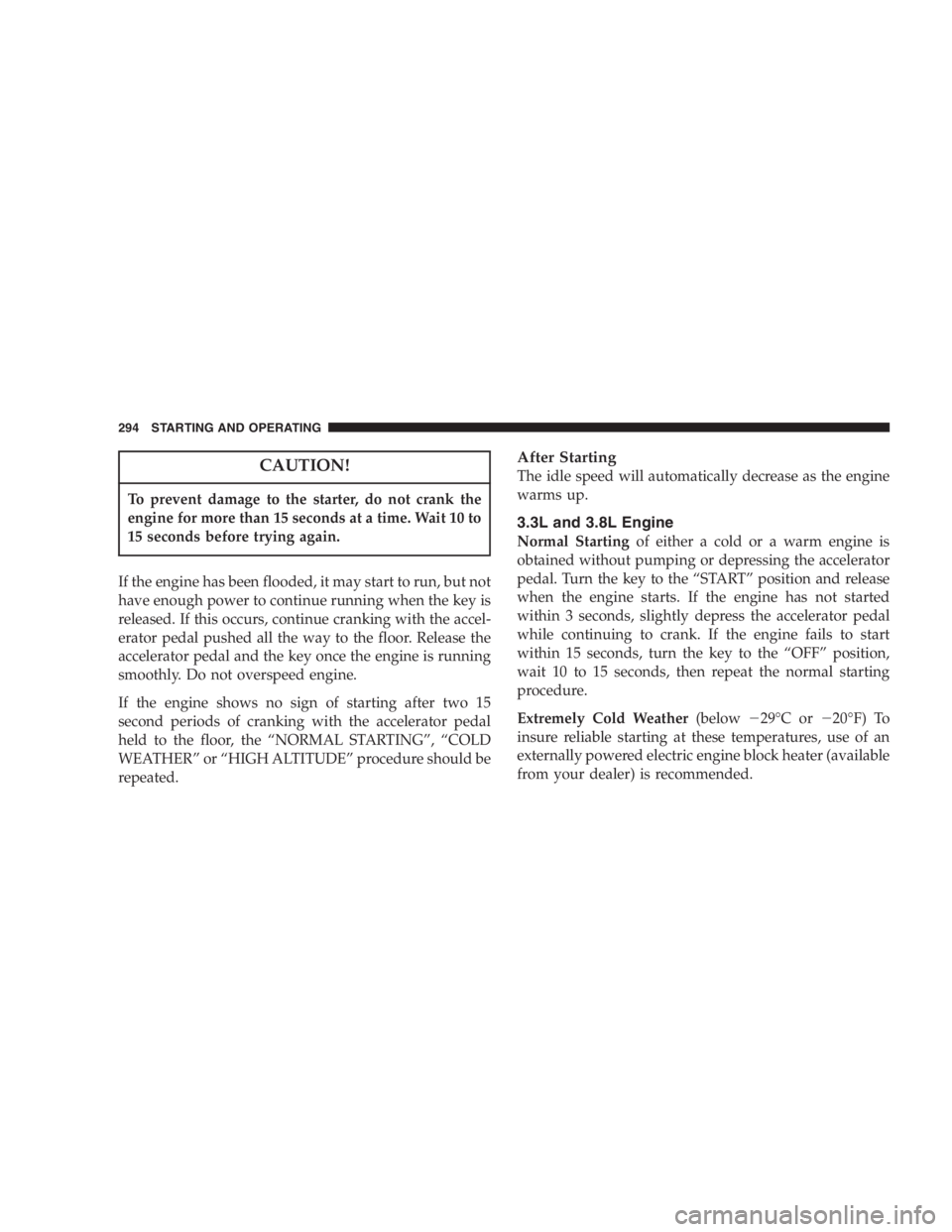Page 269 of 480

A/C Recirculation Programming
The recirculation control is programmed to cancel the
recirculation mode when the ignition key is turned OFF
and will reset to outside air mode when the ignition key
is turned ON. The frequent use of outside air will help
keep odors from building up within the air conditioner-
heater housing. It is recommended that the recirculation
mode be used as little as possible, especially in humid
climates.
For hot and dry climates, or people who are allergic to
pollen and find frequent use of the recirculation mode
necessary, the recirculation mode can be programmed to
not automatically reset to the outside mode by using the
following procedures:
• Turn the ignition switch to the OFF position.
• Set the mode control to “ PANEL ” .
• Depress and hold in the “ Rear Wipe/Wash ” button. • Start the engine, and continue to hold in the “ Rear
Wipe/Wash ” button until the indicator light starts
flashing repeatedly.
• Press the recirculation button until the indicator light
remains lit.
• The selection will be stored when the ignition switch is
turned OFF or if the “ Rear Wipe/Wash ” button is
pressed.
If the recirculation indicator light is lit, the recirculation
mode will not reset when the engine is started. If the
recirculation indicator light is not lit, the recirculation
mode will reset to the outside air mode when the engine
is started. The programmed status can be changed back
and forth by following the above mentioned procedure. UNDERSTANDING YOUR INSTRUMENT PANEL 269
4
Page 271 of 480
The center knob on the front climate control unit has five
positions, “ REAR ” , “ OFF ” , and a range of blower speeds.
Only when the primary control for the rear blower is in
the “ REAR ” position do the second seat occupants have
control of the rear blower speed.
The rear blower control, located in the headliner near the
center of the vehicle has an OFF position and 3 blower
speed positions. This allows the second seat occupants to
control the volume of air circulated in the rear of the
vehicle. CAUTION!Interior air enters the Manual Rear Zone Climate
Control system through an intake grille located in
the passenger side trim panel behind the third seat.
The heater outlets are located in the passenger side
trim panel just behind the sliding door. Do not block
or place objects directly in front of the inlet grille or
heater outlets. The electrical system could overload
causing damage to the blower motor. UNDERSTANDING YOUR INSTRUMENT PANEL 271
4
Page 281 of 480

Rear Blower Control
The rear blower control, located in
the headliner near the center of
the vehicle has an “ OFF ” ,
“ AUTO ” and a range of blower
speeds.
The rear blower control knob can be manually set to
“ OFF ” or any fixed blower speed by rotating the knob
from low to high. This allows the rear seat occupants to
control the volume of air circulated in the rear of the
vehicle. CAUTION!Interior air enters the Rear Automatic Temperature
Control System through an intake grille located in
the passenger side trim panel behind the third seat.
The heater outlets are located in the passenger side
trim panel just behind the sliding door. Do not block
or place objects directly in front of the inlet grille or
heater outlets. The electrical system could overload
causing damage to the blower motor.
Rear Temperature Control
To change the temperature in the rear of the vehicle, press
the temperature control button down for cold and up for
heated air. UNDERSTANDING YOUR INSTRUMENT PANEL 281
4
Page 283 of 480

glycol antifreeze coolant in water is recommended. Refer
to section 7, Maintenance Procedures, of this manual for
proper coolant selection.
Winter Operation
To insure the best possible heater and defroster perfor-
mance, make sure the engine cooling system is function-
ing properly and the proper amount, type, and concen-
tration of coolant is used. Refer to section 7, Maintenance
Procedures, of this manual for proper coolant selection.
Use of the air Recirculation mode during winter months
is not recommended because it may cause window
fogging.
Vacation Storage
Anytime you store your vehicle, or keep it out of service
(i.e. vacation) for two weeks or more, run the air condi-
tioning system at idle for about five minutes in the fresh
air and high blower setting. This will insure adequate system lubrication to minimize the possibility of com-
pressor damage when the system is started again.
Window Fogging
Vehicle windows tend to fog on the inside in mild rainy
or humid weather. To clear the windows, select � defrost �
or � mix � mode and increase the front blower speed. Do
not use the Recirculation mode without A/C for long
periods as fogging may occur.
Outside Air Intake
Make sure the air intake, located directly in front of the
windshield, is free of obstructions such as leaves. Leaves
collected in the air intake may reduce airflow and if they
enter the plenum they could plug the water drains. In
winter months make sure the air intake is clear of ice,
slush and snow. UNDERSTANDING YOUR INSTRUMENT PANEL 283
4
Page 289 of 480
STARTING AND OPERATINGCONTENTS � Starting Procedures .....................292
▫ 2.4L Engine .........................292
▫ 3.3L And 3.8L Engine ..................294
� Engine Block Heater — If Equipped .........296
� Automatic Transmission ..................297
▫ Brake/Transmission Interlock System .......298
▫ Automatic Transmission Ignition
Interlock System ......................298
▫ Four Speed Automatic Transmission ........298 � Parking Brake .........................301
� Brake System ..........................302
▫ Anti-Lock Brake System — If Equipped .....303
� Power Steering ........................305
� Traction Control — If Equipped ............306
� Tire Safety Information ...................308
▫ Tire Markings ........................308
▫ Tire Identification Number (TIN) ..........311
▫ Tire Loading And Tire Pressure ...........3125
Page 293 of 480

Extremely Cold Weather (below � 29 ° Cor � 20 ° F). To
insure reliable starting at these temperatures, use of an
externally powered electric engine block heater (available
from your dealer) is recommended.
WARNING!Do not attempt to push or tow your vehicle to get it
started. Vehicles equipped with an automatic trans-
mission cannot be started this way. Unburned fuel
could enter the catalytic converter and once the
engine has started, ignite and damage the converter
and vehicle. If the vehicle has a discharged battery,
booster cables may be used to obtain a start from a
booster battery or the battery in another vehicle. This
type of start can be dangerous if done improperly.
See section 6 of this manual for the proper jump
starting procedures and follow them carefully. WARNING!Never pour fuel or other flammable liquid into the
throttle body air inlet opening in an attempt to start
the vehicle. This could result in flash fire causing
serious personal injury.
If Engine Fails to Start
If the engine fails to start after you have followed the
“ NORMAL STARTING ” , “ COLD WEATHER ” or “ HIGH
ALTITUDE ” procedures, it may be flooded. Push the
accelerator pedal all the way to the floor and hold it there
while cranking the engine. This should clear any excess
fuel in case the engine is flooded. STARTING AND OPERATING 293
5
Page 294 of 480

CAUTION!To prevent damage to the starter, do not crank the
engine for more than 15 seconds at a time. Wait 10 to
15 seconds before trying again.
If the engine has been flooded, it may start to run, but not
have enough power to continue running when the key is
released. If this occurs, continue cranking with the accel-
erator pedal pushed all the way to the floor. Release the
accelerator pedal and the key once the engine is running
smoothly. Do not overspeed engine.
If the engine shows no sign of starting after two 15
second periods of cranking with the accelerator pedal
held to the floor, the “ NORMAL STARTING ” , “ COLD
WEATHER ” or “ HIGH ALTITUDE ” procedure should be
repeated. After Starting
The idle speed will automatically decrease as the engine
warms up.
3.3L and 3.8L Engine
Normal Starting of either a cold or a warm engine is
obtained without pumping or depressing the accelerator
pedal. Turn the key to the “ START ” position and release
when the engine starts. If the engine has not started
within 3 seconds, slightly depress the accelerator pedal
while continuing to crank. If the engine fails to start
within 15 seconds, turn the key to the “ OFF ” position,
wait 10 to 15 seconds, then repeat the normal starting
procedure.
Extremely Cold Weather (below � 29 ° Cor � 20 ° F) To
insure reliable starting at these temperatures, use of an
externally powered electric engine block heater (available
from your dealer) is recommended.294 STARTING AND OPERATING
Page 296 of 480

CAUTION!To prevent damage to the starter, do not crank the
engine for more than 15 seconds at a time. Wait 10 to
15 seconds before trying again.
If the engine has been flooded, it may start to run, but not
have enough power to continue running when the key is
released. If this occurs, continue cranking up to 15
seconds with the accelerator pedal pushed all the way to
the floor. Release the accelerator pedal and the key once
the engine is running smoothly. Do not overspeed en-
gine.
If the engine shows no sign of starting after two 15
second periods of cranking with the accelerator pedal
held to the floor, the “ NORMAL STARTING ” procedure
should be repeated. After Starting
The idle speed will automatically decrease as the engine
warms up.
ENGINE BLOCK HEATER — IF EQUIPPED
The engine block heater warms engine coolant and
permits quicker starts in cold weather. Connect the cord
to a standard 110-115 volt AC electrical outlet with a
grounded, three-wire extension cord.
The engine block heater cord is routed under the hood on
the driver side of the vehicle. It has a removable cap that
is located on the driver side of the Integrated Power
Module.296 STARTING AND OPERATING